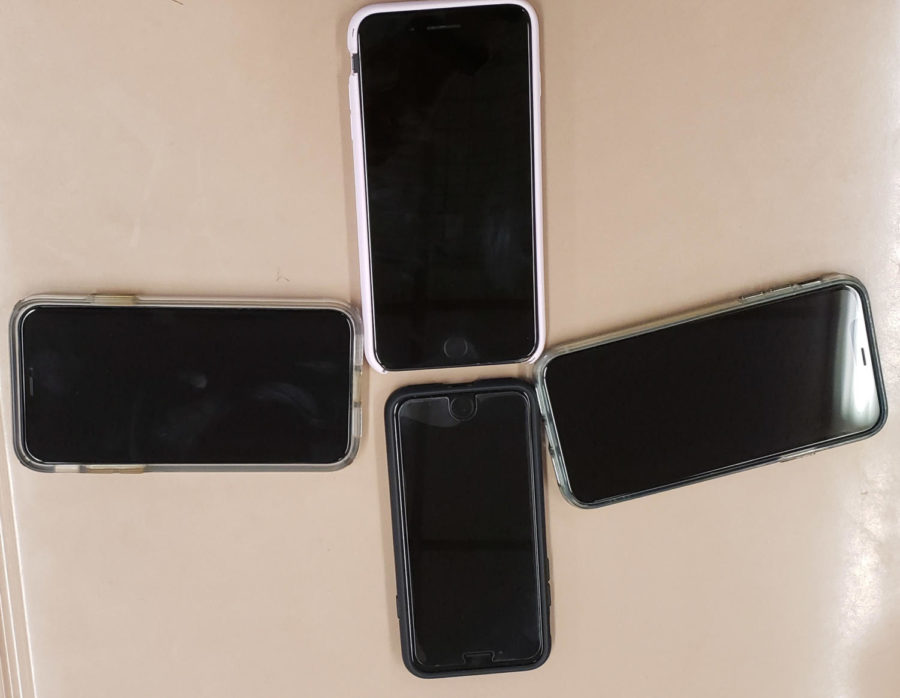A look into the top school distraction — Smartphones
iPhones are the most widely used smartphone among younger generations.
A student walks into their classroom just before the bell rings. He proceeds to pull out his most prized possession — his phone. His teacher repeatedly reminds him to stow his device away, but is desperate to send his last snap. He is so used to this daily habit that he can barely pull his eyes away from it.
Over the past few years, students throughout all levels of school have incorporated checking their text messages and social media while in the classroom.
A study done by the University of Nebraska-Lincoln discovered that college students are spending a lot more time on their phone, an average of up to 11 times per day. In retrospect, 86 percent of college students check their phones for text messages are in the 60th percentile range for checking emails and social media. Less than ten percent are actually playing mobile games while in the classroom as well.
These statistics are reflected in high schools, as said by Junior Caleb Turner. He described what apps students use the most before school.
“[Students mostly use] Snapchat, Tik Tok, Instagram, and mainly messaging,” Turner said. He also described how often he uses his smartphone when present at school. “I go on it before every class period, and once or twice during class too, I mainly use it for checking messages or listening to music,” Turner said.
While using your smartphone in class is usually prohibited, it has become the normal routine when walking from class to class. DGS English teacher Dan Maas described how often he reminds his students to put their phones away.
“With my freshman classes, it’s two or three times a week. Once class starts, I give them a minute to power down, though there may be one remaining student I have to constantly remind, but [it] is very minimal,” Maas said. He also explained how this differs for upperclassman.
“I tend to give them a little more leeway and decision making if they are going to have their devices out versus my freshman where I don’t want them visible,” Maas said
While students constantly checking their phone during any given day may seem as a harmless habit, the journal “Educational Psychology” had a study that shows a correlation with smartphones in classrooms contributing to lower grades. Researchers divided two groups of college students with one having laptops and cellphones and the others not having any tech devices. The group using the devices scored about half a letter grade lower on exams.
However, students who didn’t use the devices but were in the same classroom also scored lower. This is all likely due to distractions from the nearby devices. This study has shown “the ultimate effect of divided attention in class on final exam performance,” as quoted from the published study.
Despite knowing that using devices in the classroom play a negative role, senior Oscar Gabriel gave insight on how checking his phone could be beneficial. “I check it just to be sure if they are any emergencies or things happening around school[to be up to date],” Gabriel said.
According to the novel, The Distracted Mind: Ancient Brains In A High Tech-World, students tend to become distracted when they are attempting to achieve a goal. Although something blocks their efforts to achieve it. That is a direct result of students constantly relying on their phones as well as using any form of technology on a daily basis. In other words, a students’ attention in the classroom is now divided between two tasks: what the teacher is trying to teach and what the students are attempting to accomplish using a tech device.
While a policy with banning phones seems like a last resort, Gabriel commented further on the potential solution he can see to limit students from using their devices in class. “I know that a lot of students know their ways to get access to the [school] Wi-Fi code, so making it harder to get it may make students not want to go on their phones,” Gabriel said.
Maas also gave input on the potential solutions to solving the gap between technology and the lack of attention in school.“Any increased technology in the room is a potential benefit and an extra responsibility put on the students shoulders,” Maas said. He believes educating students on technology use in school is the most effective solution.
“I think educating students on how to manage and understand that responsibility better, it’s not a policy thing but how students each decide to personally handle engaging in technology,” Maas said.



Mathew M Rusky • Oct 22, 2019 at 11:24 am
Love the deep dive into the distraction of cell phones. Would have loved to see more solutions from the author or from his sources. I think this is overall another good article by Greyson Martinescu.
